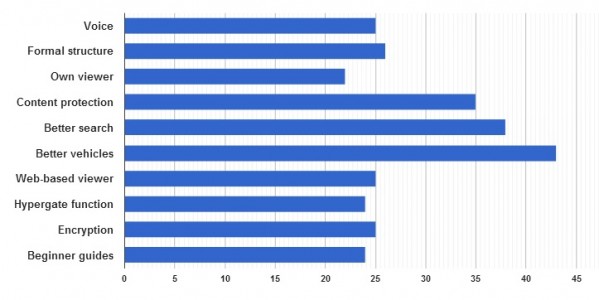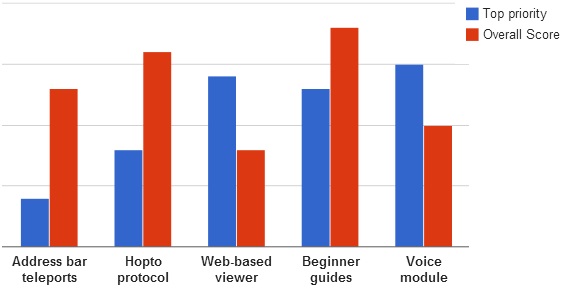
OpenSim users chose “better vehicles and physics” as a top priority more than any other feature in a Hypergrid Business survey this past week. You can see the raw results of the survey here.
Overall, 43 respondents out of 143, or 31 percent, said that better vehicles and physics were “a top priority for OpenSim’s future.”
OpenSim recently updated its physics engine to Bullet, as a result of a great deal of work by developers from Intel. However, this has created a great deal of confusion — many existing scripts have been adapted to run under ODE, the previous default engine. Bullet is more like Second Life, so the ODE-optimized scripts need to be replaced. Not all grids have switched over, however, and individual region owners can choose which physics engine is used on their region.
To make things even more confusing, InWorldz, OpenSim’s most popular grid, has its own physics thing going on.
After physics, the next top-priority feature was search. Here are the leading top-priority features, in order:
- Better vehicles and physics
- Better search functionality
- Better protection for in-world content
- A more formal structure for OpenSim, including ability to take donations and pay developers
- Browser-based viewer
- A good voice module
- Encryption for communications, including for text chat, voice, and hypergrid.
- Built in hypergate functionality that supports external queries
- Expand OpenSim documentation with more beginner guides
- A viewer unique to OpenSim, developed from scratch, and independent of Second Life
The only one of the above that might not be self-explanatory is the hypergate functionality. This was one of my two suggestions to improve search, the other being a new built-in, searchable events functionality linked to groups.
Currently, there is no one single built-in function that indicates that an object is a hypergate. Instead, there is an almost infinite variety of scripts, gate designs, and special effects. As a result, there is no way for a spider, say, to tell what outbound links a region has without touching or colliding with or sitting on every single object there — clearly impractical and extremely CPU-intensive.
I proposed a new functionality, similar to media-on-a-prim, that would indicate that a particular surface was a hypergate. The functionality would come with a default animated hypergate texture, a default special effect, a default whoosh sound effect, and a choice of activation options — touch, collide, or sit — based on the local threat levels.
In addition, a grid would keep track of all these outbound links and, unless they were set to private, report them on request — possibly via a static page updated once a day or so, to avoid any additional load on the database. With a separate description field, the hypergate function would also make it easier for text-only viewers to identify hypergates — and, in combination with the name of the destination grid and region, have enough text for searches to be useful.
A hypergate feature would require close collaboration between server and viewer developers, and — like the export feature before it — move OpenSim viewers onto their own path, separate from Linden Lab.
I also added up all the scores that a particular feature got, counting “don’t care” as zero, “nice but not necessary” as one, “would be great to have” as two, “very important” as four, and “top priority” as eight, and ranked all features by these total scores. The idea was to find features that were important to a lot of people, but maybe weren’t considered as much of a top priority.

It was interesting to me that teleport-related functions — entering a destination address via the address bar instead of via Map>Search and entering a destination via the Web browser bar and having it automatically launch a viewer to take you there — did significantly better when “very important” and “would be great to have” scores were added in.
I interpret this to mean that these are much-wanted features, but not as immediately critical as some of the other ones, such as a browser-based viewer and voice.
A ranking of the features by their overall scores:
- Better vehicles and physics
- Better search functionality
- Expand OpenSim documentation with more beginner guides
- Better protection for in-world content
- Full implemenation of the hopto or similar protocol to allow for easy logins or direct teleports to in-world locations
- Encryption for communications, including for text chat, voice, and hypergrid.
- A more formal structure for OpenSim, including ability to take donations and pay developers
- Ability to enter hypergrid address directly into the address bar as well as Map>Search
- A viewer unique to OpenSim, developed from scratch, and independent of Second Life
- Built-in hypergate functionality that supports external queries
- Analysts predict drop in headset sales this year - March 25, 2025
- OSgrid enters immediate long-term maintenance - March 5, 2025
- OSgrid wiping its database on March 21: You have five weeks to save your stuff - February 15, 2025
